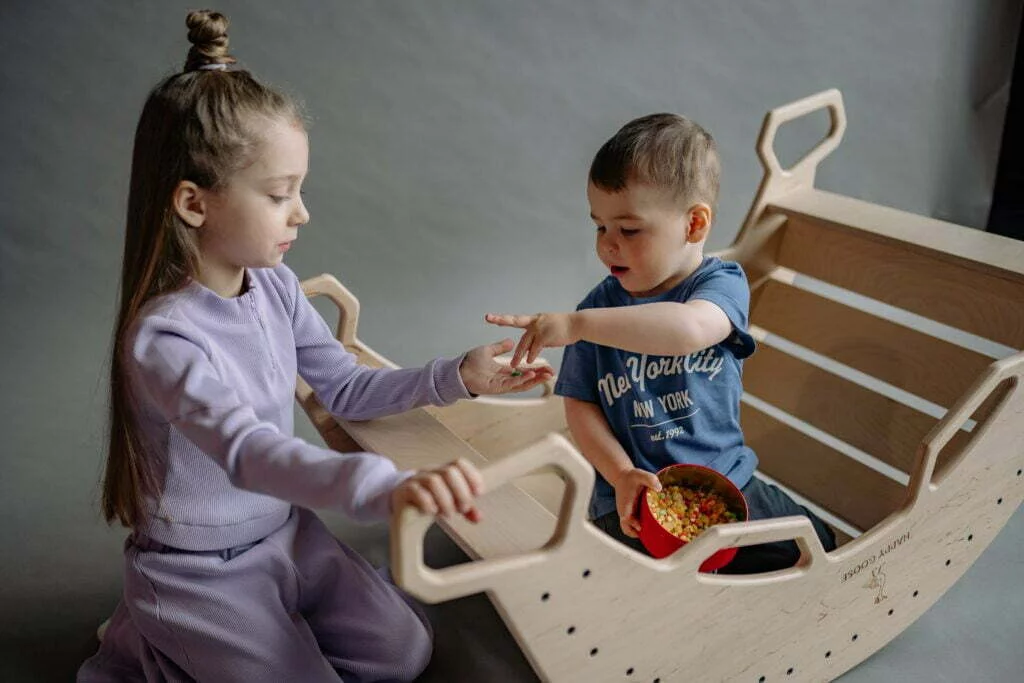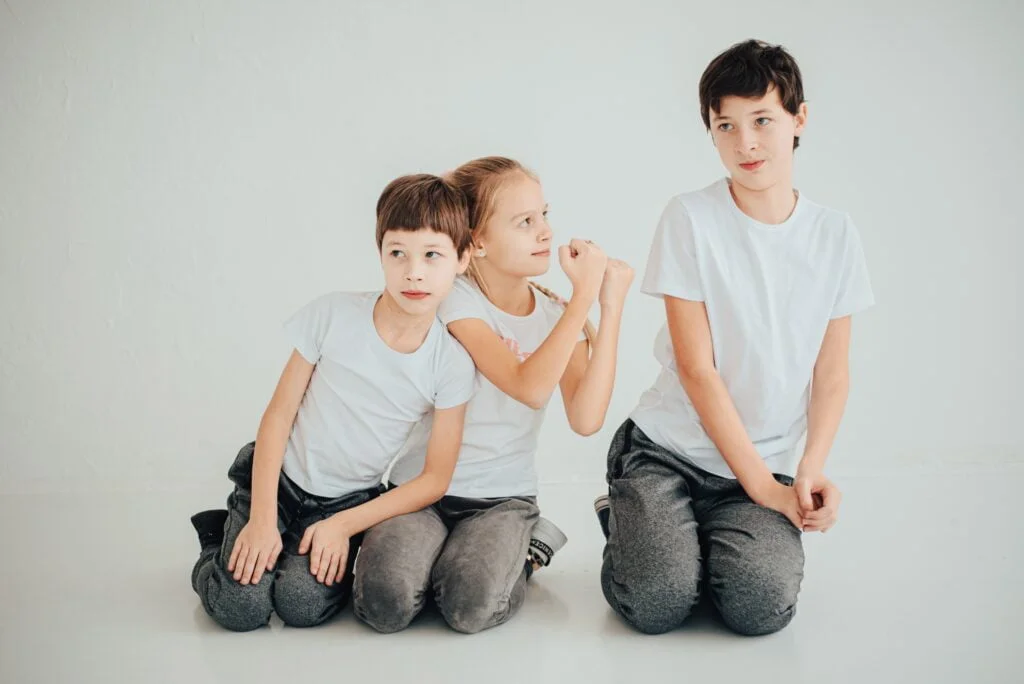Big sisters and little brothers share a unique bond, filled with laughs, squabbles, and heartwarming moments.
Ever wondered what makes their relationship so special?
Dive with us into this dynamic realm, where every disagreement hides a lesson, and every shared laughter strengthens an unbreakable bond.
If you’ve ever wondered about the magic and mystery behind this unique sibling relationship, you’re in for a captivating journey.
Some of the links in this post are affiliate links. This means if you click on the link and purchase the item, I will receive an affiliate commision at no extra cost to you. All opinions remain my own. Read more on our Privacy Policy Page
MAGBLOCK 176PCS Magnetic Tiles Pipe Magnetic Blocks

The Root of the Rivalry – Big Sisters and Little Brothers
Big sisters and little brothers: a duo that’s a bundle of laughs, challenges, and heartwarming moments. But what really sparks the occasional tug-of-war between them?
Born from Evolution
Nature wired us for competition. In the sibling world, this translates to vying for the best toys, the coziest spot on the couch, or even mom and dad’s attention. When a younger brother enters the scene, the elder sister’s solo spotlight dims, igniting a natural rivalry.
Mind Matters
Imagine juggling the roles of a sibling and a mini-parent. It’s a tightrope walk for big sisters. They often shoulder responsibility, while little brothers wrestle to carve their own identity, away from their sister’s protective shadow. These internal battles can sometimes lead to external squabbles.
The Weight of Tradition
Around the globe, big sisters often hear, “Look out for your little brother.” It’s an age-old song. But when does looking out become too much? These expectations can make little brothers feel smothered and sisters feel burdened.
Clash of Characters – Big Sisters and Little Brothers
Beyond age and roles, personalities come into play. Imagine a bold sister paired with a laid-back brother. Fireworks or a harmonious symphony? Sometimes, it’s not about being elder or younger but just about being different.
Territory Troubles
Every home has its hotspots – the best seat for cartoons, the favorite toy, or the choice of Friday night movies. These become mini battlefields where both try to plant their flags.
Peeling back the layers of this rivalry, we find a mix of biology, emotions, and societal cues. While tiffs are a given, so are moments of pure love and camaraderie. And that’s what makes this sibling dance so beautifully complex.
>>> Enhance Sibling Bonding with Our Recommended Products!

The Age Gap Dilemma – Big Sisters and Little Brothers
The age gap between siblings, especially big sisters and little brothers, paints a fascinating picture of shared childhood experiences. But this difference in years can sometimes feel like they’re from different planets. Let’s decode the magic and mayhem that this gap brings.
Different Worlds Collide
Imagine a big sister engrossed in her latest teen novel, while her little brother is fervently building a Lego tower nearby. They’re in the same room, but their worlds are miles apart. She’s navigating the challenges of adolescence; he’s conquering the playground.
Tastes and Interests
Saturday morning and there’s a scramble for the remote. She’s rooting for a teen drama, while he’s set on the latest superhero cartoon. Their varied interests, stemming from their age difference, mean that finding common ground can sometimes be a mini adventure.
Lessons and Leadership – Big Sisters and Little Brothers
Big sisters often end up playing the role of a guide, inadvertently sharing snippets of wisdom acquired from their extra years. They teach, sometimes without realizing, while little brothers bring fresh perspectives, reminding their sisters of the joys of innocence and wonder.
Navigating Social Circles
While she might be busy with high school friendships and the whirlwind of teenage life, he’s figuring out sandbox politics. These diverse social challenges might seem unrelated, but they offer each sibling a unique sneak peek into the other’s world.
Sharing and Understanding
An age gap can initially feel like a barrier, but it’s also an opportunity. As they grow, big sisters and little brothers can learn to bridge their differences, sharing experiences, stories, and understanding that adds richness to their bond.
In the grand tapestry of siblinghood, age differences add unique colors and patterns. It’s a journey of discovery, patience, and learning, making the relationship between big sisters and little brothers all the more special.
Inique Christams Gifts for Your Brother! Read More
Gender Stereotypes
Big Sisters and Little Brothers
In the dynamic between big sisters and little brothers, the invisible hand of gender stereotypes often plays a role, subtly shaping expectations, behaviors, and interactions. Understanding these stereotypes can shed light on some of the complexities that characterize their relationship.
The Nurturer and The Protector
From fairy tales to modern media, big sisters are often portrayed as the caregivers, the responsible ones, nurturing and offering guidance. On the other hand, little brothers, despite their younger age, are sometimes expected to grow up to be the “protectors”, eventually taking on roles of strength and assertiveness.
Interests and Activities
Stereotypes seep into the activities deemed “appropriate” for each gender. She might be encouraged towards dolls and arts, while he might be handed cars and action figures. These seemingly harmless choices can influence their interests and how they perceive each other’s roles.
Emotional Expressions
While girls are often allowed a broader emotional canvas, boys are frequently nudged to suppress emotions. “Boys don’t cry” contrasts sharply with a big sister’s ability to openly express feelings, creating potential misunderstandings.
Leadership Dynamics
In many cultures, even if the sister is older, there’s an unspoken expectation that the brother will eventually assume a leadership role within the family or community. This can impact the power dynamics between siblings, with sisters feeling undermined and brothers feeling undue pressure.
Challenging Stereotypes
As society evolves, there’s a growing awareness of the limitations of gender stereotypes. Many families are actively breaking these molds, allowing their children to define their own identities. Big sisters can be fierce protectors, and little brothers can be sensitive and nurturing. Recognizing and challenging these stereotypes not only fosters individual growth but also strengthens the bond between siblings.
In essence, while gender stereotypes have historically played a role in shaping the interactions between big sisters and little brothers, there’s a refreshing shift towards more fluid, individualized understandings of gender roles. This evolution promises a more harmonious, understanding, and enriched sibling dynamic.
>>> Enhance Sibling Bonding with Our Recommended Products!

Embracing the Differences – Big Sisters and Little Brothers
At the crossroads of sibling dynamics, the differences between big sisters and little brothers often stand out. But instead of viewing them as roadblocks, let’s see them as the very essence that spices up their relationship.
The Adventure of Varied Interests
She’s into dance; he’s obsessed with the latest video game. While it might seem like they’re poles apart, these varied passions can lead to unique shared experiences. Imagine him teaching her a gaming strategy or her showing him some dance moves. It’s about swapping worlds for a day and creating memorable moments.
Maturity Meets Freshness
Her added years bring a layer of maturity. He brings a fresh, unfiltered view of the world. When combined, you get a perfect mix of wisdom and wonder. She provides insights, while he keeps things light with his infectious enthusiasm.
Dynamics of Decision-making
Differing ages and perspectives mean they won’t always see eye to eye. But this is where the magic lies. Negotiating, compromising, and sometimes agreeing to disagree, they learn the essential life skills of decision-making together.
Learning Through Stories
With distinct life experiences, they have unique tales to tell. He talks about his day at the playground, while she shares high school drama. Through these stories, they offer each other glimpses into their worlds, promoting understanding and empathy.
Building Bridges
Differences aren’t divides; they’re opportunities to build bridges. The joy lies in discovering common ground amidst diversity, whether it’s a shared hobby, a favorite song, or even a mutual dislike.
In the sibling playbook, differences don’t have to be hurdles. When embraced with an open heart, they enrich the bond between big sisters and little brothers, turning everyday moments into treasured memories.
Fun Outdoor Games for Siblings to Strengthen Their Bond
7 Steps to Navigate the Rivalry between Big Sister and Little Brothers
1. Talk It Out
- Encouraging open communication can be transformative. When siblings freely express their emotions and concerns, many disputes can be swiftly addressed, paving the way for mutual understanding.
2. Discover Shared Interests
- Identifying and exploring mutual hobbies or passions can foster deeper connections. Be it teaming up for a puzzle or engaging in an art project, such activities can build bridges and reduce feelings of competition.
3. Individual Time
- Prioritizing personal time with each child is essential. It allows parents to cater to the unique needs and interests of each sibling, ensuring neither feels overshadowed by the other.
4. Equip with Peace Tools
- Conflict resolution skills are invaluable. Equip them with techniques like using calm words, practicing patience, or seeking mediation from a neutral party. These tools can transform potential conflicts into growth opportunities.
5. Celebrate Differences
- Instead of focusing on differences as divisive, treat them as strengths. Highlighting how each sibling’s unique traits contribute to the family can lead to appreciation and respect.
6. Set Clear Boundaries
- Having specific rules and boundaries fosters a sense of fairness. Whether it’s about respecting personal space or sharing communal areas, clarity can be a preventive measure against many disputes.
7. Lead by Example
- Children absorb behaviors they observe. By showcasing positive interactions and problem-solving approaches, parents can indirectly instill these behaviors in their kids.
JOLLY FUN Dance Mat for Kids – Electronic Dance Mats with Wireless Bluetooth for 3-12 Year Old Kids,


In Closing – Big Sisters and Little Brothers
The dance between big sisters and little brothers is a captivating one, filled with ups, downs, and countless shared memories.
While the journey might be sprinkled with moments of rivalry, with understanding and the right tools, these moments can transform into stepping stones for a deeper bond.
Embrace the differences, celebrate the shared joys, and remember: the relationship between big sisters and little brothers is truly one of life’s unique treasures.
FAQs:
How can I be a good big sister to my little brother?
Being a good big sister involves understanding, patience, and open communication. Spend quality time with your little brother, engage in activities he enjoys, and always be there to lend a listening ear. It’s also essential to be a positive role model; showing kindness, respect, and empathy in your actions can influence him more than words.
What is good behavior for a big sister?
Good behavior for a big sister revolves around responsibility, respect, and understanding boundaries. This means not only guiding and supporting your younger sibling but also giving him space to grow and learn independently. Be patient when disagreements arise, avoid being overly bossy, and always approach situations with empathy.
What makes a strong big sister?
A strong big sister is resilient, compassionate, and understanding. She stands up for her little brother, provides guidance without being overbearing, and knows the value of mutual respect. Strength isn’t just about protection but also about knowing when to step back, let him learn from his experiences, and be there to support him in his triumphs and failures.
Sibling rivalry is normal — but is it helpful or harmful?






